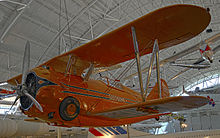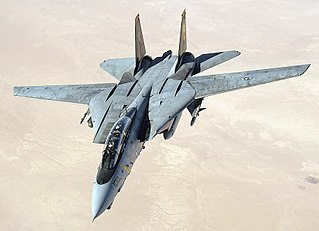
The Grumman F-14 Tomcat is an American carrier-capable supersonic, twin-engine, two-seat, twin-tail, all-weather-capable variable-sweep wing fighter aircraft. The Tomcat was developed for the United States Navy's Naval Fighter Experimental (VFX) program after the collapse of the General Dynamics-Grumman F-111B project. A large and well-equipped fighter, the F-14 was the first of the American Teen Series fighters, which were designed incorporating air combat experience against MiG fighters during the Vietnam War.

The McDonnell FH Phantom is a twinjet fighter aircraft designed and first flown during World War II for the United States Navy. The Phantom was the first purely jet-powered aircraft to land on an American aircraft carrier and the first jet deployed by the United States Marine Corps. Although only 62 FH-1s were built it helped prove the viability of carrier-based jet fighters. As McDonnell's first successful fighter, it led to the development of the follow-on F2H Banshee, which was one of the two most important naval jet fighters of the Korean War; combined, the two established McDonnell as an important supplier of navy aircraft.

The Brewster F2A Buffalo is an American fighter aircraft which saw service early in World War II. Designed and built by the Brewster Aeronautical Corporation, it was one of the first U.S. monoplanes with an arrestor hook and other modifications for aircraft carriers. The Buffalo won a competition against the Grumman F4F Wildcat in 1939 to become the U.S. Navy's first monoplane fighter aircraft. Although superior to the Grumman F3F biplane it replaced, and the early F4Fs, the Buffalo was largely obsolete when the United States entered the war, being unstable and overweight, especially when compared to the Japanese Mitsubishi A6M Zero.

The McDonnell F2H Banshee is a single-seat carrier-based jet fighter aircraft designed and produced by the American aircraft manufacturer McDonnell Aircraft. It was an early jet fighter operated by United States Navy and United States Marine Corps, as well as being the only jet-powered fighter to ever be deployed by the Royal Canadian Navy. The aircraft's name is derived from the banshee of Irish mythology.

The Grumman F4F Wildcat is an American carrier-based fighter aircraft that entered service in 1940 with the United States Navy, and the British Royal Navy where it was initially known as the Martlet. First used by the British in the North Atlantic, the Wildcat was the only effective fighter available to the United States Navy and Marine Corps in the Pacific Theater during the early part of the Second World War. The disappointing Brewster Buffalo was withdrawn in favor of the Wildcat and replaced as aircraft became available.

The Grumman C-1 Trader is a carrier onboard delivery (COD) variant of the Grumman S-2 Tracker. It was replaced by a similar version of the Northrop Grumman E-2 Hawkeye, the Grumman C-2 Greyhound.

The Grumman F6F Hellcat is an American carrier-based fighter aircraft of World War II. Designed to replace the earlier F4F Wildcat and to counter the Japanese Mitsubishi A6M Zero, it was the United States Navy's dominant fighter in the second half of the Pacific War. In gaining that role, it prevailed over its faster competitor, the Vought F4U Corsair, which initially had problems with visibility and carrier landings.

The Grumman F7F Tigercat is a heavy fighter aircraft that served with the United States Navy (USN) and United States Marine Corps (USMC) from late in World War II until 1954. It was the first twin-engine fighter to be deployed by the USN. While the Tigercat was delivered too late to see combat in World War II, it saw action as a night fighter and attack aircraft during the Korean War.

The Grumman F8F Bearcat is an American single-engined, carrier-based, fighter aircraft introduced in late World War II. It served during the mid-20th century in the United States Navy, the United States Marine Corps, and the air forces of other nations. It was Grumman Aircraft's last piston-engined fighter aircraft.
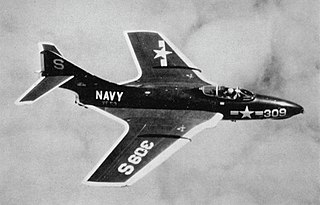
The Grumman F9F/F-9 Cougar is a carrier-based jet-powered fighter aircraft designed and produced by the American aircraft manufacturer Grumman.

The Blackburn B-24 Skua was a carrier-based low-wing, two-seater, single-radial engine aircraft by the British aviation company Blackburn Aircraft. It was the first Royal Navy carrier-borne all-metal cantilever monoplane aircraft, as well as the first dive bomber in Fleet Air Arm (FAA) service. The aircraft took its name from the sea bird which 'divebombs' any potential predators that come too close to its nest.

The Ryan FR Fireball was an American mixed-power fighter aircraft designed by Ryan Aeronautical for the United States Navy during World War II. It was the Navy's first aircraft with a jet engine. Only 66 aircraft were built before Japan surrendered in August 1945. The FR-1 Fireball equipped a single squadron before the war's end, but did not see combat. The aircraft ultimately proved to lack the structural strength required for operations aboard aircraft carriers and was withdrawn in mid-1947.
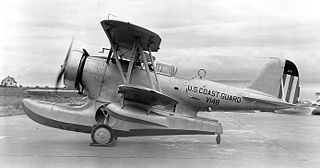
The Grumman JF "Duck" was an American single-engine amphibious biplane built by Grumman for the United States Navy during the 1930s. The J2F Duck was an improved version of the JF, with its main difference being a longer float.

The Grumman F2F was a single-engine, biplane fighter aircraft with retractable undercarriage, serving as the standard fighter for the United States Navy between 1936 and 1940. It was designed for both carrier- and land-based operations.

The Grumman XF5F Skyrocket was a prototype twin-engined shipboard fighter interceptor. The United States Navy ordered one prototype, model number G-34, from Grumman Aircraft Engineering Corporation on 30 June 1938; its designation was XF5F-1. The aircraft had a unique appearance: The forward "nose" of the fuselage did not extend forward of the wing. Provisions were included for two 20 mm (0.787 in) Madsen cannon as armament.

The Grumman FF "Fifi" was an American biplane fighter aircraft operated by the United States Navy during the 1930s. It was the first carrier aircraft with retractable landing gear. It was produced under licence in Canada and known as the Goblin in Canadian service and Delfín in Spanish service.
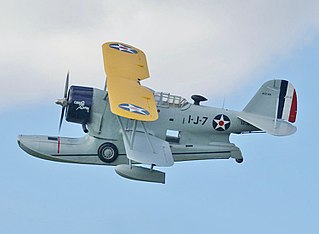
The Grumman J2F Duck is an American single-engine amphibious biplane. It was used by each major branch of the U.S. armed forces from the mid-1930s until just after World War II, primarily for utility and air-sea rescue duties. It was also used by the Argentine Navy, who took delivery of their first example in 1937. After the war, J2F Ducks saw service with independent civilian operators, as well as the armed forces of Colombia and Mexico.

The Curtiss F11C Goshawk is an American naval biplane fighter aircraft that saw limited success. It was part of a long line of Curtiss Hawk airplanes built by the Curtiss Aeroplane and Motor Company for the American military.

The Gregor FDB-1 was a Canadian biplane fighter, designed in 1938 by Michael Gregor and manufactured by Canadian Car and Foundry. Despite having some advanced design features such as flush rivetted all-metal construction and a retractable undercarriage, the final generation of biplane fighters was being supplanted by monoplanes and the Gregor FDB-1 was obsolete before it flew. Despite the Royal Canadian Air Force's desperation for modern fighters, the sole example remained unsold and was eventually lost in a fire in 1945. The Gregor FDB-1's model designation stood for Fighter Dive Bomber indicating its intended roles.

The Grumman XSBF, also known by the company designation G-14, was an American biplane scout bomber developed by Grumman Aircraft for the United States Navy during the 1930s. Derived from Grumman's successful "Fifi" fighter, the aircraft was developed at a time when the biplane was giving way to the monoplane. In competition against other aircraft it proved to possess inferior performance in its intended role, and did not enter production. The sole prototype went on to serve as a liaison aircraft, as well as being used in experiments by NACA, before being destroyed in a crash in 1939.



